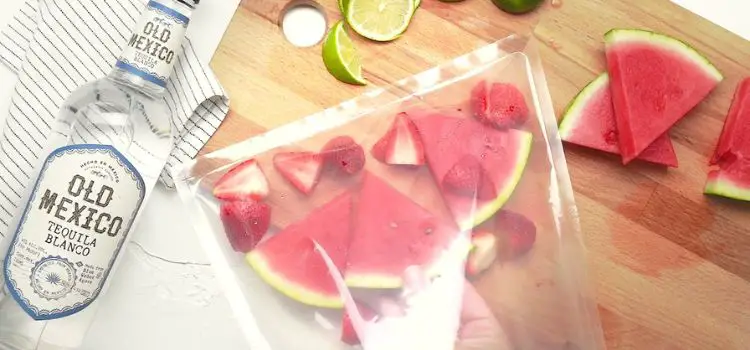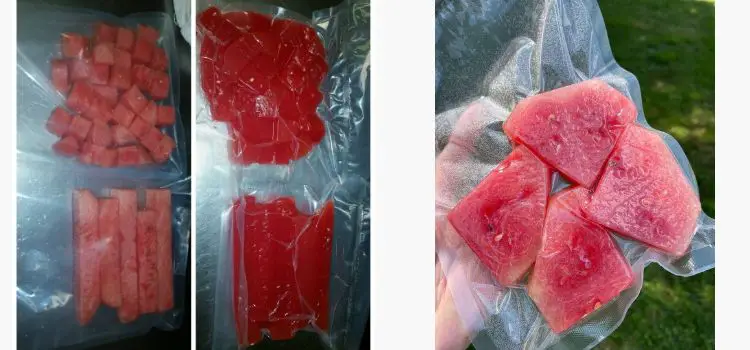As an Amazon Associate, I earn from qualifying purchases

Vacuum sealing has revolutionized the way we store food, offering a method to extend shelf life, preserve flavors, and reduce waste. This technique involves removing air from packaging, which slows down the oxidation process and prevents spoilage. While vacuum sealing is commonly used for meats, cheeses, and dry goods, adventurous home cooks often wonder about its application to more unconventional items, like watermelon.
This article explores the feasibility of vacuum sealing watermelon, addressing the challenges, providing a step-by-step guide, and offering storage tips to ensure your watermelon stays fresh and delicious.
Challenges of Vacuum Sealing Watermelon
Watermelon presents unique challenges when it comes to vacuum sealing, primarily due to its high water content. Comprising about 92% water, watermelon is prone to texture changes when vacuum sealed. The pressure from the vacuum can crush the fruit, leading to a mushy consistency that might not be appealing.
Additionally, the natural sugars and juices in watermelon can be drawn out during the vacuum process, potentially altering its flavor. Maintaining the fruit’s integrity and taste requires careful handling and the right techniques.
Step-by-Step Guide to Vacuum Sealing Watermelon
Despite the challenges, vacuum sealing watermelon is possible with the right approach. Here’s a step-by-step guide to help you achieve the best results:
- Selecting the Right Type of Watermelon
Choose a firm, ripe watermelon that is free from blemishes or soft spots. A seedless variety is preferable, as seeds can complicate the sealing process and affect the texture.
- Preparing and Cutting Watermelon for Sealing
- Wash and Dry: Thoroughly wash the watermelon to remove any dirt or bacteria. Pat it dry with a clean towel.
- Cut into Chunks: Slice the watermelon into manageable chunks or cubes. Smaller pieces are easier to seal and store.
- Remove Excess Moisture: Lay the watermelon pieces on a paper towel to absorb excess moisture. This step is crucial to prevent the vacuum from drawing out too much juice.
- Proper Vacuum Sealing Techniques to Maintain Quality
- Use a Quality Vacuum Sealer: Invest in a reliable vacuum sealer that allows you to control the pressure. Some models have a gentle setting for delicate items like fruits.
- Pre-Freeze the Pieces: For best results, pre-freeze the watermelon chunks on a baking sheet for about 30 minutes. This helps them retain their shape during sealing.
- Seal with Care: Place the pre-frozen watermelon pieces in a vacuum seal bag, leaving some space between each piece. Use the gentle setting to seal the bag, ensuring minimal pressure is applied.
Storage Tips for Vacuum-Sealed Watermelon

Once sealed, proper storage is key to maintaining the quality of your vacuum-sealed watermelon.
Ideal Storage Conditions for Longevity
Store the vacuum-sealed watermelon in the freezer for long-term preservation. Freezing helps maintain the fruit’s texture and flavor, allowing you to enjoy it months later.
How to Monitor and Maintain Seal Integrity
Regularly check the seal for any signs of air leakage. If the seal is compromised, reseal the bag to prevent spoilage. Properly sealed watermelon can last up to 12 months in the freezer.
Best Practices for Using Vacuum-Sealed Watermelon
When ready to use, thaw the watermelon in the refrigerator. This gradual thawing process helps retain its texture. Vacuum-sealed watermelon is perfect for smoothies, fruit salads, or as a refreshing snack.
Conclusion
Vacuum sealing watermelon is a practical way to extend its shelf life and reduce waste, especially during peak seasons when the fruit is abundant. While it presents some challenges due to its high water content, following the right techniques can help preserve its flavor and texture.
Experimenting with vacuum sealing different foods can open up new possibilities in your kitchen, allowing you to enjoy seasonal produce year-round. With a bit of practice and the right approach, vacuum sealing watermelon can become a valuable addition to your food preservation toolkit.
FAQ
Can you vacuum seal fresh watermelon?
Yes, you can vacuum seal fresh watermelon, but it requires careful preparation due to its high water content. Cut the watermelon into chunks, pre-freeze them to retain shape, and use a gentle vacuum setting to avoid crushing. This method helps preserve its freshness and flavor.
How to compress watermelon with a vacuum sealer?
To compress watermelon, slice it into chunks and pre-freeze for about 30 minutes. Use a vacuum sealer with a gentle setting to minimize pressure. This process removes air and intensifies flavors, creating a unique texture perfect for innovative culinary presentations and recipes.
What fruits can you vacuum seal?
You can vacuum seal a variety of fruits, including berries, apples, pears, peaches, and mangoes. Ensure they are dry and cut into manageable pieces. Pre-freezing delicate fruits helps maintain texture, making them ideal for smoothies, desserts, and long-term storage while preserving their freshness.
As an Amazon Associate, I earn from qualifying purchases